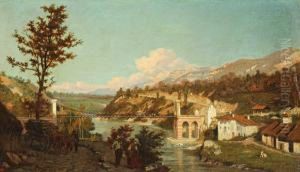Henri Mmare Paintings
Henri Matisse, born Henri Émile Benoît Matisse on December 31, 1869, in Le Cateau-Cambrésis, France, is often regarded as one of the pivotal figures in the development of modern art during the early 20th century. His career spanned over six decades, during which he delved into various artistic mediums, including painting, drawing, sculpture, and printmaking, as well as pioneering in the cut-out technique. Matisse’s work is celebrated for its vibrant use of color and fluid draughtsmanship. He was a leader of the Fauvist movement, a group of early 20th-century modern artists whose works emphasized painterly qualities and strong color over the representational or realistic values retained by Impressionism.
Matisse's journey into the art world was unconventional. Initially, he studied law and worked as a court administrator in Le Cateau-Cambrésis. His path took a dramatic turn in 1890 when, during a period of convalescence following an appendicitis attack, his mother brought him art supplies, and he discovered his passion for painting. Subsequently, he moved to Paris to study art, learning from masters such as William-Adolphe Bouguereau and Gustave Moreau at the Académie Julian and the École des Beaux-Arts, respectively. Matisse's early works were influenced by the Impressionists, notably Cézanne and Van Gogh, whose influences are evident in his palette and brushwork.
The turn of the century marked a significant evolution in Matisse's style. His work began to exhibit the expressive use of color and less conventional representations of form that would become hallmarks of Fauvism. The 1905 Salon d'Automne exhibition was a defining moment for Matisse and his contemporaries, where their boldly colored, expressive artworks earned them the label 'Les Fauves' (wild beasts). Despite the initial shock and criticism from the art world, Matisse continued to explore and refine his aesthetic, leading to a more balanced and harmonious approach in his later works.
Matisse's artistic career was also marked by his rivalry and friendship with Pablo Picasso, another towering figure of modern art. The two artists were both competitive and influential to each other's work, pushing the boundaries of contemporary art. During World War II, Matisse, who lived in Nice, France, continued to create, despite the difficult circumstances. His later years were characterized by innovation in paper cut-outs, a technique he turned to in earnest when his health made traditional painting challenging. These works, made by cutting and arranging painted paper, are among his most celebrated and include large-scale compositions such as 'The Snail' and the design of the Chapelle du Rosaire in Vence, France.
Henri Matisse passed away on November 3, 1954, in Nice. His legacy is that of a pioneer who continually sought to challenge and expand the boundaries of visual expression. Matisse's work has had a lasting impact on the trajectory of modern art, influencing countless artists and movements that followed. He is remembered not only for his contributions to Fauvism but also for his relentless pursuit of artistic innovation and expression.
